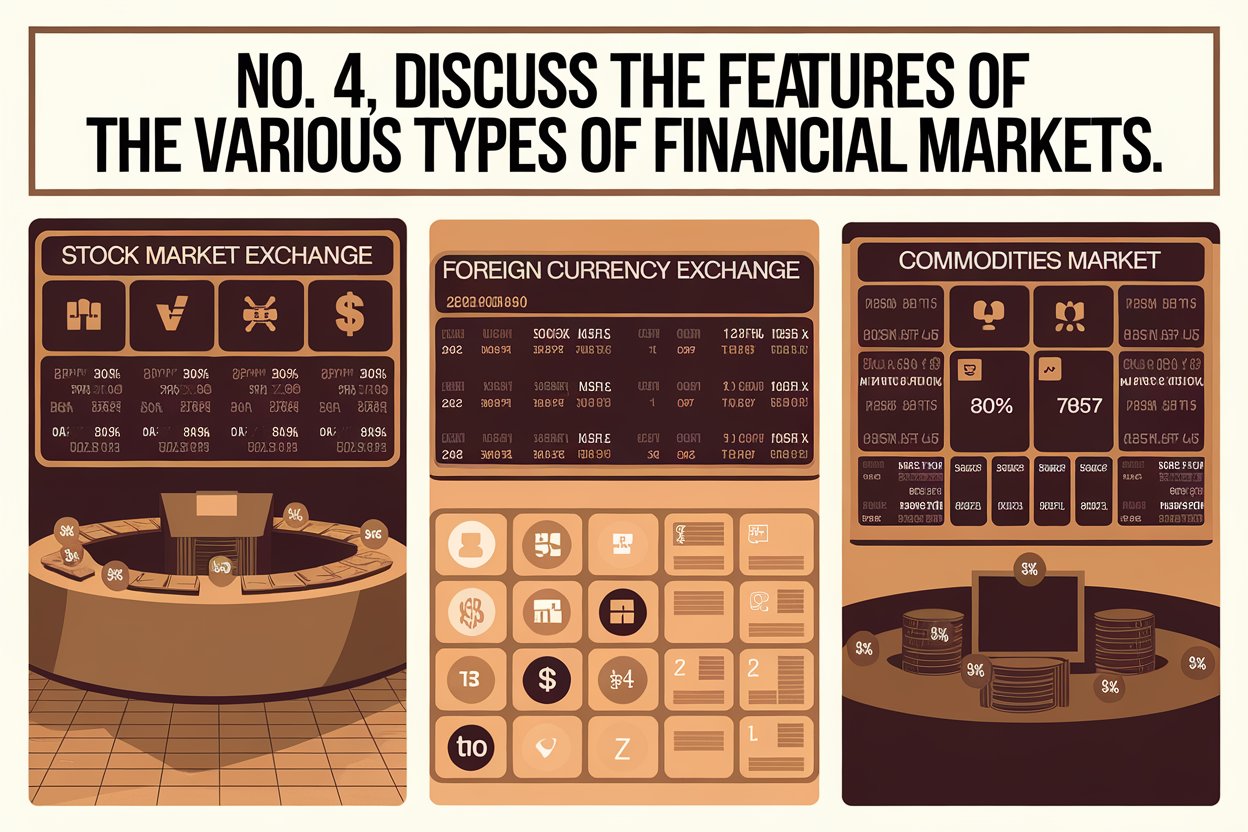Business AdministrationCSS
Q. No. 4. Discuss the features of the various types of Financial Markets.

- Currency Market:
The currency market bargains in transient obligation instruments with developments of short of what one year. It is utilized by legislatures, enterprises, and monetary establishments to oversee momentary subsidizing needs.
Highlights:
- Transient Instruments: Instruments like Depository charges, declarations of store (Albums), and business paper rule the currency market.
- Profoundly Fluid: Protections are effectively convertible into cash because of short developments.
- Okay: Because of brief lengths, these instruments are for the most part safer and give lower returns contrasted with long haul speculations.
- Huge Institutional Members: States, enormous companies, and monetary foundations essentially work in the currency market.
- Over-the-Counter Market (OTC): Most currency market exchanges happen in an OTC setting as opposed to on conventional trades.
- Capital Market:
The capital market is worried about long haul supporting through the issuance of stocks and securities. It is partitioned into the essential market (where new protections are given) and the optional market (where it are exchanged to exist protections).
Highlights:
- Long haul Instruments: Protections like values (stocks) and bonds, with development periods more than one year, are exchanged.
- Two Sub-Markets:
- Essential Market: Organizations raise capital by giving new stocks or securities.
- Auxiliary Market: Financial backers exchange recently gave protections. Stock trades like the NYSE and NASDAQ work with this.
- Hazard and Return: Interests in the capital market commonly imply higher gamble yet in addition higher potential returns contrasted with the currency market.
- Wide Cooperation: Both institutional financial backers (benefits reserves, shared assets) and individual financial backers take part.
- Guideline: Capital business sectors are managed by protections commissions (e.g., the SEC in the U.S.) to guarantee straightforwardness and reasonableness.
- Unfamiliar Trade (Forex) Market:
The forex market is where monetary standards are exchanged. It is the biggest monetary market on the planet, working all day, every day.
Highlights:
- Money Exchanging: Includes the trading of one cash for another, still up in the air by organic market.
- Worldwide Nature: The forex market is decentralized and works across various time regions.
- Profoundly Fluid: The market’s immense size and worldwide extension guarantee high liquidity.
- Unstable and Theoretical: Costs can change quickly founded on financial information, international occasions, and market theory.
- Members: Key members incorporate national banks, monetary foundations, partnerships, mutual funds, and retail brokers.
- Subsidiaries Market:
This market bargains in monetary instruments whose worth is gotten from a hidden resource, like stocks, securities, items, or monetary standards.
Highlights:
- Influence: Subsidiaries like choices, prospects, and trades permit members to acquire openness to resources without expecting to claim the actual resource, prompting high influence.
- Risk The executives: They are frequently utilized for supporting to oversee risk in portfolios.
- Hypothesis: Subsidiaries draw in brokers hoping to conjecture on the future value developments of hidden resources.
- Intricacy: Subsidiaries are complicated instruments that expect mastery to comprehend and make due.
- High Unpredictability: Because of influence, the cost of subsidiaries can be very unstable.
- Item Market:
In the item market, unrefined components or essential farming items are exchanged. Items incorporate metals, energy items, and farming merchandise.
Highlights:
- Physical and Monetary Items: Products can be physical (like oil, gold, wheat) or monetary (like ware prospects contracts).
- Two Kinds of Business sectors:
- Spot Market: Where items are traded for guaranteed conveyance.
- Prospects Market: Where agreements are made for the future conveyance of items.
- Affected by Organic Market: Costs in ware markets are driven by market interest factors, international issues, and atmospheric conditions.
- Supporting and Hypothesis: Makers, shoppers, and brokers utilize the ware market to fence against cost changes, while examiners endeavor to benefit from these vacillations.
- Obligation Market: (Security Market)
The obligation market includes the exchanging of securities or different types of obligation protections. It permits substances to get cash from financial backers in return for occasional premium installments.
Highlights:
- Fixed Pay Protections: Bonds are the essential instruments, giving normal premium installments (coupon installments) to financial backers.
- Lower Chance: Bonds are for the most part considered lower risk than stocks, yet they offer lower returns.
- Extensive variety of Guarantors: State run administrations, regions, partnerships, and monetary organizations issue bonds.
- Kinds of Securities: Securities can be arranged into government securities, corporate securities, metropolitan securities, and sovereign securities.
- Auxiliary Market: After issuance in the essential market, securities can be exchanged on the optional market, where their costs vary in light of loan fees and credit scores.
- Protection Market:
This market bargains in the exchange of hazard between parties through insurance policies.
Highlights:
- Risk Move: People or substances move the gamble of monetary misfortune to insurance agency.
- Premium Installments: Policyholders pay expenses in return for inclusion against explicit dangers (e.g., life, wellbeing, property).
- Institutional Nature: Enormous institutional elements like insurance agency rule this market.
- Guideline: Protection markets are vigorously managed to safeguard policyholders and keep up with market respectability.
- Actuarial Science: Valuing in the insurance market depends on actuarial examinations to survey risk probabilities and payment sums.